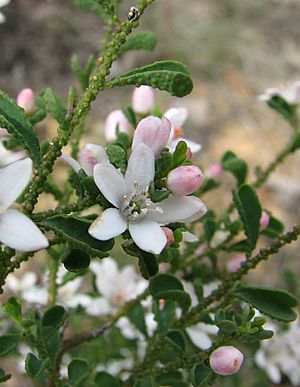Fairy wax-flower facts for kids
Quick facts for kids Fairy wax-flower |
|
|---|---|
 |
|
| Philotheca verrucosa | |
| Scientific classification | |
| Genus: |
Philotheca
|
| Species: |
verrucosa
|
| Synonyms | |
|
|
The Philotheca verrucosa, often called fairy wax-flower or Bendigo wax-flower, is a beautiful flowering plant. It belongs to the Rutaceae family, which also includes citrus fruits. This plant is endemic to south-eastern Australia, meaning it naturally grows only there.
It's a small shrub with unique bumpy branches. Its leaves are shaped like hearts or eggs. The plant produces pretty white flowers, usually one at a time, near its leaves.
Contents
What Does the Fairy Wax-Flower Look Like?
The fairy wax-flower is a small shrub. It usually grows to about 80 centimeters (about 31 inches) tall. Sometimes, it can even reach 2 meters (about 6.5 feet) high. Its branches have small, bumpy glands, like tiny warts.
The leaves are directly attached to the stem. They are shaped like a heart or an egg, with the narrower part at the bottom. Each leaf is about 6 to 15 millimeters long and 4 to 7 millimeters wide. The underside of the leaves also has these bumpy glands. The leaves can be flat or folded lengthwise.
The flowers usually grow one by one from where the leaves meet the stem. Each flower sits on a short stalk, about 0.5 to 2 millimeters long. The flower itself has another small stem, called a pedicel, which is 1 to 4 millimeters long.
Each flower has five round, fleshy sepals, which are like small green leaves protecting the bud. These are about 1 millimeter long. There are also five white, oval-shaped petals, each about 6 millimeters long. Inside the flower, you'll find ten stamens, which are the parts that produce pollen. These stamens are covered in tiny hairs.
You can see the fairy wax-flower in bloom from August to October.
How Was the Fairy Wax-Flower Named?
The fairy wax-flower was first officially described in 1834. A scientist named Achille Richard gave it the name Erisotemon verrucosus. He wrote about it in a book called Voyage de découvertes de l'Astrolabe - Botanique.
Later, in 1998, another scientist named Paul Wilson changed its name. He moved it to the Philotheca group, giving it the name Philotheca verrucosa. This change was published in a science journal called Nuytsia.
Where Does the Fairy Wax-Flower Grow?
The fairy wax-flower likes to grow on rocky hills. You can find it in forests and woodlands. Sometimes, it also grows in sandy heathland areas.
This plant is found in several parts of south-eastern Australia. It grows in South Australia, Victoria, and Tasmania.
In South Australia, it lives in the Mount Lofty Ranges. In Victoria, you can find it in places like Grampians, the Bendigo area, and Gippsland. It also grows in eastern Tasmania.
Growing Fairy Wax-Flower in Your Garden
The fairy wax-flower is a great plant for gardens. You can grow new plants from small tip cuttings. It can handle frost well and doesn't need a lot of water, making it quite drought-tolerant.
Some types of fairy wax-flower have extra petals. This makes their flowers look even fuller, with double or multiple layers of petals.
There's also a special type called Philotheca 'Flower Girl'. This plant is a cultivar, which means it was created by crossing two different plants. Scientists believe it's a mix of the fairy wax-flower and the Philotheca myoporoides. 'Flower Girl' produces many light pink to white flowers during winter and spring. It can grow to be between 1 and 2 meters (about 3 to 6.5 feet) tall.

